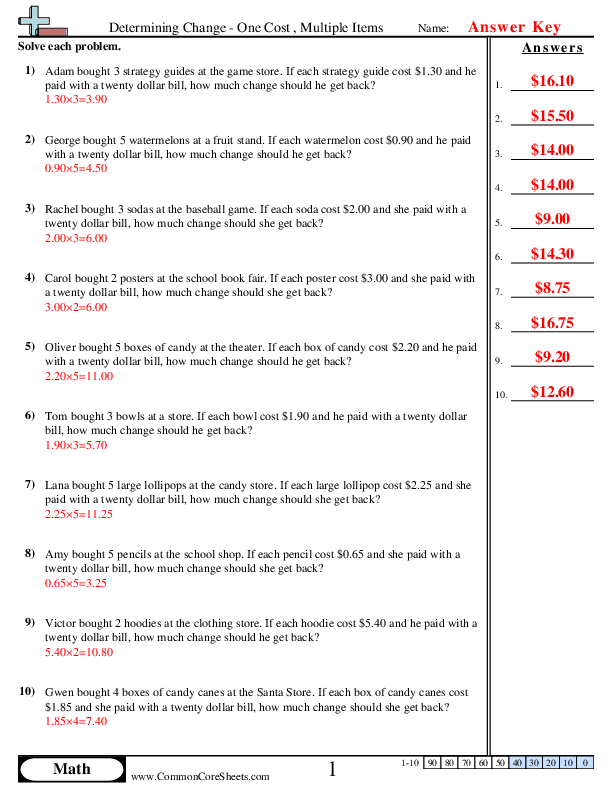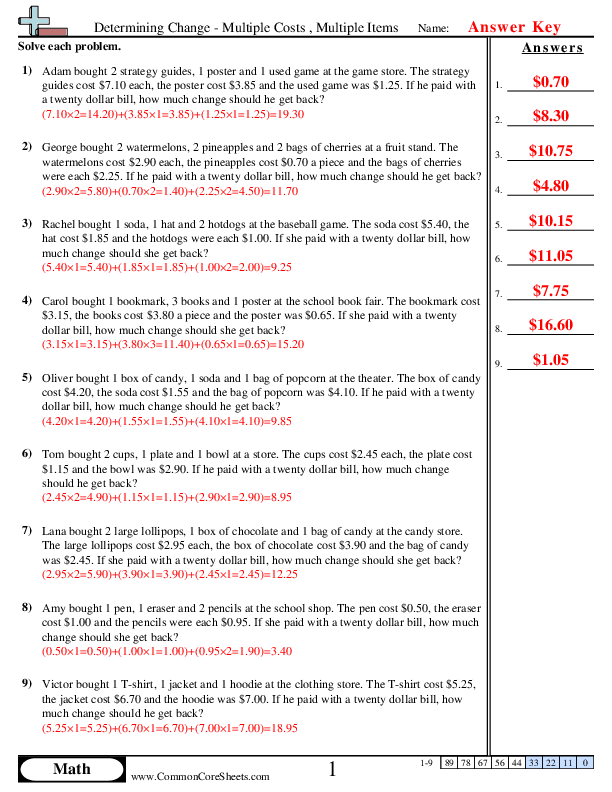Money worksheets are a great tool for teaching kids how to identify and add or subtract money. Our money worksheets are the best on the internet and are perfect for kids in elementary school. With a variety of fun and engaging activities, these worksheets will help kids learn about counting coins, making change, and identifying currency. The best part is that they are all free to download and print. These money worksheets are a must-have resource for any teacher. So why wait? Download our free money worksheets today and give your kids the skills they need to succeed with money!
Browse Sheets By Problem Type
×
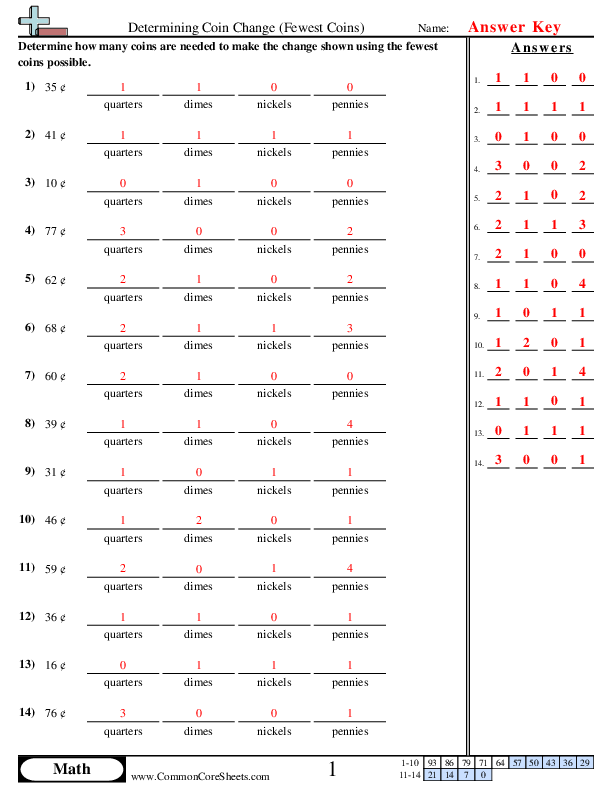
Determining Coin Change (Fewest Coins)


×
Description:
"This worksheet is designed to refine children's math skills by determining the fewest possible coins to equal a cent amount. Featuring 14 problems, pupils will learn coin values, enhancing their counting and problem-solving abilities. Versatile in use, this education tool can be customized to fit individual needs, transformed into flash cards for better retention, or incorporated in distance learning modules. A practical tool to make learning fun and constructive."

×
Student Goals:
Enhanced knowledge of coinsAfter completing this worksheet, students should be able to identify and understand the values of quarters, dimes, nickels, and pennies. They should develop a better knowledge of these coins, their differences, and how they fit in the monetary system. This increased understanding lays the foundation for more advanced financial lessons in the future.Improved mathematical skillsThis worksheet will greatly improve students' mathematical skills. By calculating the fewest coins needed for given amounts, students practice their addition and subtraction abilities, and also grow their problem-solving skills. They learn to deduce, calculate, develop strategies and solve problems, broadening their math capabilities.Adaptability to real world scenariosThe tasks in this worksheet will also help students adapt to real-world scenarios. Knowledge of coins and their values is important in everyday tasks from shopping to understanding bank statements. By learning how to efficiently give and count change, they build a practical skill that will be incredibly useful throughout their lifetime.Focus and attention developmentCompleting this worksheet enhances students' focus and attention to detail. Careful analysis is needed to determine the smallest number of coins to make up a given amount. This encourages a high level of concentration and focus, which are essential components to successful learning and are transferrable to many other subjects.Preparedness for advanced financial lessonsBy mastering the content of this worksheet, students prepare themselves for more advanced financial lessons. Skills such as counting coins make up the base knowledge required to understand complex topics like financial literacy, budgeting, and commerce in the future. This worksheet thus marks an essential step in their financial education journey.


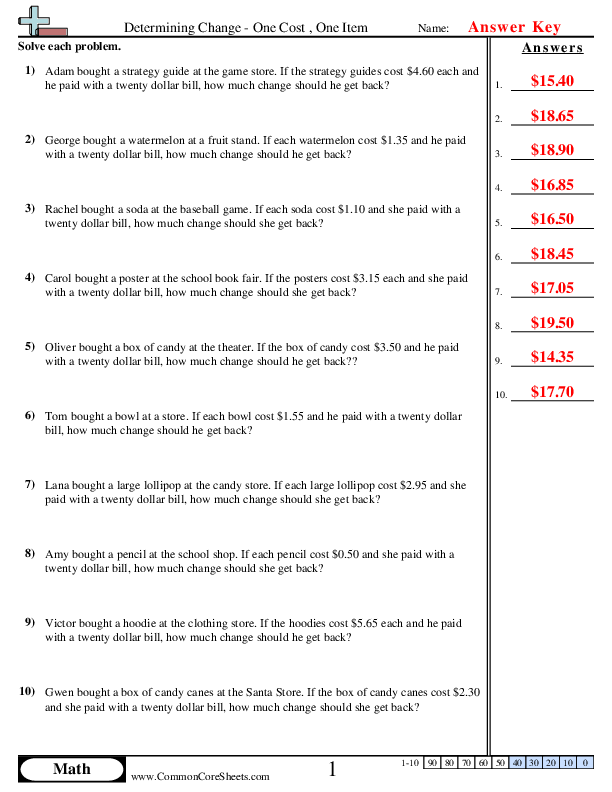
One Item - One Cost
4md2


×
Description:
"This worksheet is designed to engage and enhance children's math skills, specifically in money management and calculations. It contains ten real-world problems that involve determining change from a twenty dollar bill. Customizable for diverse learning styles, it can also be converted into flash cards or utilized for distance learning to adapt to various teaching methods."

×
Student Goals:
Understanding of Mathematical ConceptsAfter completing the worksheet, students should have a stronger grasp on basic mathematical concepts such as subtraction and understanding monetary values. They should be able to comfortably and accurately perform the operation of subtraction to calculate the change that is expected from different transactions. Additionally, they should also understand the value of different denominations of money, and be able to conceptualize what it means to pay for something and receive change.Skills in Practical ApplicationThe students will also gain skills in the practical application of mathematics. The worksheet is designed around real-world scenarios, helping students understand how math applies in everyday life. This should enable them to make the connection between abstract mathematical problems and the application of those mathematical principles in real-life scenarios.Problem Solving and Critical ThinkingSuccess at this worksheet demands critical thinking and problem-solving as well. Students must interpret the problem, break it down into the mathematical operations required, and carry out the calculations correctly. Thus, this practice should help improve their abilities to think critically and approach the problems systematically, enhancing their overall problem-solving skills.Ability to Work IndependentlyCompleting this worksheet helps students develop their ability to work independently. It requires them to understand the problem, decide on the best approach, carry out the necessary steps and verify their answers without direct teacher intervention, thus boosting their confidence in their own abilities to independently tackle and solve problems.Accuracy and Attention to DetailLastly, students will enhance their accuracy and attention to detail. With numerical operations, even a slight miscalculation or overlooking of values can lead to wrong answers. Therefore, this worksheet will train them to closely scrutinize the numbers involved and check their calculations, reinforcing their accuracy and attention to detail in math and beyond.


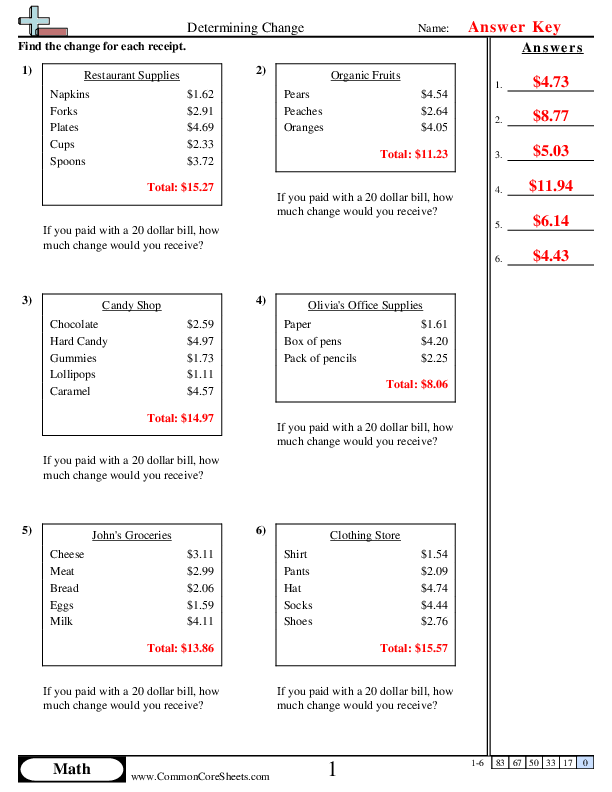
Receipt Change
4md2


×
Description:
"This worksheet is designed to enhance children's understanding of basic math through real-world scenarios. Focused on 'Determining Change,' it offers six practical problems, allowing children to apply subtraction concepts by calculating the change from a $20 bill. Perfect for customizable learning, this worksheet can also be transformed into flash cards or utilized in distance learning settings, promoting active and versatile education."

×
Student Goals:
Understanding the Concept of ChangePost completion of this worksheet, students will gain a solid understanding of the concept of 'change' in monetary transactions. They will understand how to calculate the change that is due when a specific amount of money is used to pay for items worth less than that amount.Enhancing Basic Arithmetic SkillsThis worksheet will provide students with several real-life examples to apply their basic arithmetic skills, particularly subtraction. By determining the change from a twenty-dollar bill in different scenarios, they will enhance their subtraction skills and develop a greater understanding of practical mathematics.Applying Math to Real World ScenariosApplying math to real-world scenarios is a necessary skillset to develop while young. Upon completing the worksheet, students will gain a better understanding of how mathematics principles are applied in everyday situations like shopping. This serves to enhance their ability to use mathematics outside the classroom environment.Improving Problem-Solving SkillsThe worksheet is designed to improve problem-solving skills amongst students. They are presented with a problem – the amount spent and the amount given – and need to work out the solution, which is the change received. This repeated exercise of problem-solving can quickly enhance their analytical and reasoning skills.Cognition of Currency ValueBy undertaking these exercises, students will develop a greater cognition of currency value. As they determine how much money is left after purchases, they understand the value of money and how much different items cost. This reinforces the concept of money value and aids in their financial literacy development.Enhancing Speed and Accuracy in CalculationsThe worksheet provides students the platform to increase their speed and accuracy in doing subtraction problems. Through repetitive practice, students can master these skills which are essential for real-world tasks as well as for a variety of other mathematics problems.


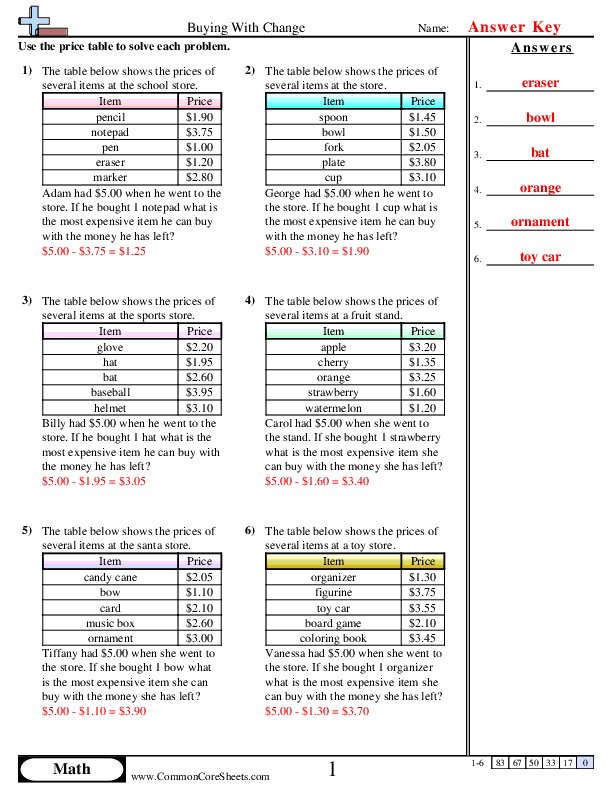
Buying With Change
4md2


×
Description:
"This worksheet is designed to teach children how to manage money by solving practical math problems. It involves pricing scenarios at six different settings, encouraging kids to calculate spending and remaining amount. These math problems can be customized, transformed into flash cards, or utilized in distance learning programs to make learning money management concepts easier and fun."

×
Student Goals:
Understand SubtractionUpon completion of the 'Buying with Change' worksheet, students should have improved their conceptual understanding of subtraction. They will be capable of performing simple subtraction problems independently, which aids in their understanding of everyday mathematics.Enhance Critical ThinkingThis worksheet is designed to help students apply critical thinking skills, as they are required to solve problems that involve making purchasing decisions with a fixed amount of money. Upon completion, learners should be able to determine the cost of items and calculate the remaining money after purchase which also develops their decision-making skills.Money Management SkillsStudents should acquire basic money management skills through this worksheet. They will learn how to plan purchases within a given budget. This important life skill will help them grasp the value of money and the concept of making economical choices.Real-life Math ApplicationStudents get to understand how mathematics is applied in real-life scenarios like shopping at stores. This understanding will be instrumental in helping them see the practical usage of math beyond the classroom.Grasp of Decimal NumbersAs the worksheet employs dollar amounts and change, students should also gain a better understanding of decimal numbers. They will learn how to subtract decimal numbers as well as understand their application in real-life situations like shopping.Problem-Solving SkillsStudents will learn to solve problems based on different scenarios. This will enhance their ability to logically think through problems, arrive at a solution, and solidify their problem-solving skills in diverse situations.


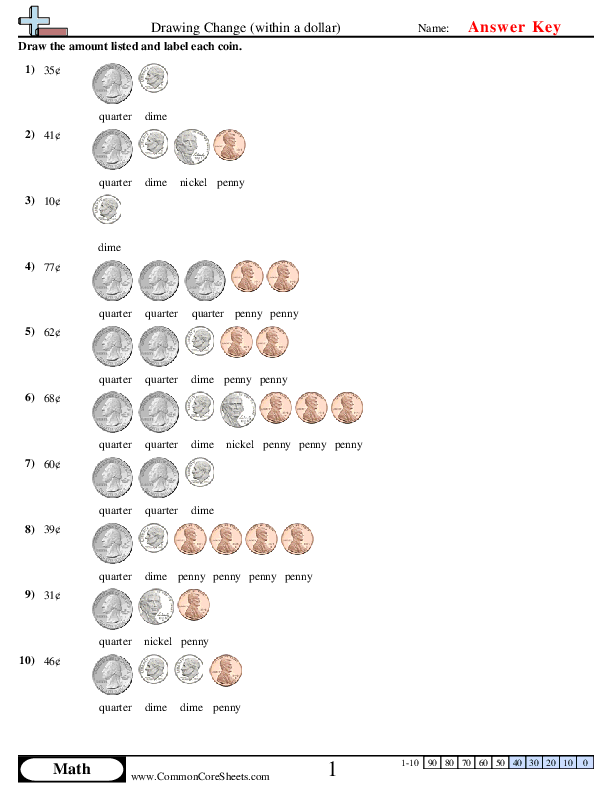
Drawing Change (within a dollar)


×
Description:
"This worksheet is designed to help children enhance their math skills through practice with coins and change. Drawing Change (within a dollar) includes 10 engaging math problems where students need to count and identify quarters, dimes, nickels, and pennies to reach a certain amount. This adaptable resource can be customized to fit any educational setting, transformed into interactive flashcards, or incorporated into distance learning programs to facilitate hands-on learning experiences."

×
Student Goals:
Mathematical ProficiencyUpon completion of this worksheet, students should have improved their mathematical proficiency, specifically within the context of financial literacy. They should be adept at recognizing and understanding the value of different coins such as quarters, dimes, nickels, and pennies and know how to combine them to achieve specific amounts. This will give them a foundational understanding of money management and arithmetic.Problem Solving SkillsDrawing Change worksheet serves as valuable practice in problem-solving. As students find the right combination of coins to match the given amount, they are developing an understanding of how many ways a particular amount can be made. They are enhancing their strategic thinking, reasoning abilities, and logical deduction skills. These skills are fundamental to complex problem-solving and could be applied to diverse areas beyond math.Cognitive AbilitiesSuccessfully completing the exercises will improve learners' cognitive abilities. By working through the problems, students should have improved concrete and abstract reasoning skills. In particular, discerning the coins' value and figuring out how to attain the desired amount with a different coin combination fosters mental agility, sharpness, and number sense. These enhancements in cognitive ability aid in overall academic achievement.Financial LiteracyThe worksheet helps students develop financial literacy at a basic level. Understanding how smaller units of currency (coins) combine to form larger units is a fundamental skill in everyday life. They become familiar with concepts of money, which is instrumental in building a strong foundation for financial management skills that are essential in their future lives.Personal AutonomyCompleting the worksheet promotes the children's personal autonomy. Being able to perform basic money mathematical tasks will give them an appreciation of the fundamental role money plays in society. They start to understand the concept of buying and selling, empowering them to make decisions involving transactions independently. This sense of responsibility aids in their personal growth and maturity.


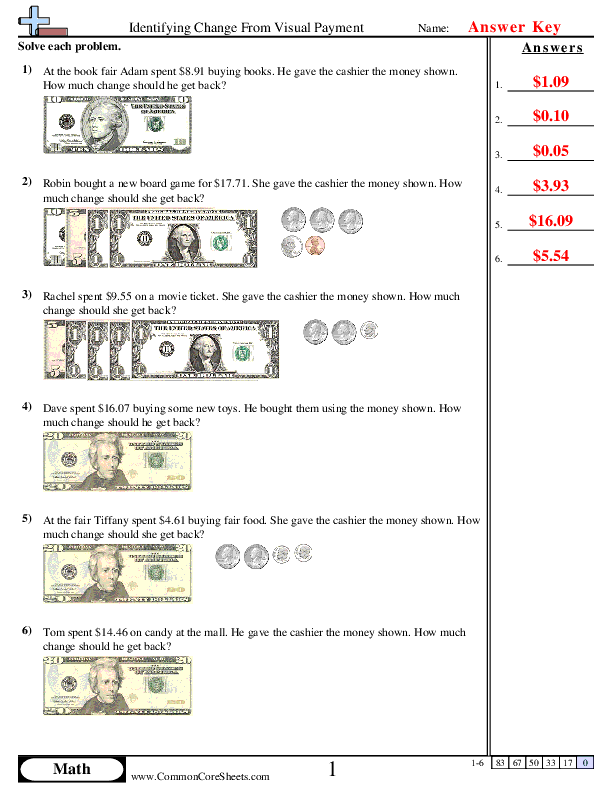
Identifying Change From Visual Payment


×
Description:
This worksheet is designed to help children master the concept of calculating change through real-world scenarios. Providing six unique math problems, it's geared towards enhancing practical money management skills. Its flexible format allows customization, conversion into flash cards, or suitability for distance learning, endorsing versatile educational methods. A hands-on approach to learning, making mathematics more tangible for young learners.

×
Student Goals:
Understanding of Money ValueStudents should enhance their understanding of the value of money. They should be able to quickly identify and understand various monetary denominations such as dollars and cents. This ability will facilitate their daily transactions and comprehension of financial exchanges.Ability to Handle MoneyChildren should develop confidence in handling money independently. Through practical situations depicted in the problems, they should realize the process of giving and receiving correct amounts. Their transactions in the real world would be more smooth and efficient.Performing Basic Arithmetic OperationsStudents should improve their ability to perform basic arithmetic operations, specifically subtraction. Each problem requires the students to subtract the cost of an item from the amount given to the cashier. This practice should strengthen their mathematical skills and promote their cognitive development.Developing Problem-Solving SkillsThis worksheet assists students in developing problem-solving skills. They are presented with scenarios of real-life situations that require mathematical calculations and logical thinking. Over time, they ought to become proficient in given situations, improving not only their problem-solving skills but also their decision-making abilities.Application of Mathematics in Daily LifeStudents should be better able to appreciate the application of math in daily life. This ability is crucial as it helps children understand the importance of math beyond the classroom setting. Their learning becomes more meaningful as they make connections between the classroom learning and real-world applications, thereby nurturing a love for the subject.Understanding of Financial ResponsibilityLastly, the worksheet aims to instil a basic understanding of financial responsibility in children. It makes them more aware of their spending habits, and the importance of noting the change after every monetary transaction. This, in turn, contributes to shaping them into financially responsible individuals in their later life.


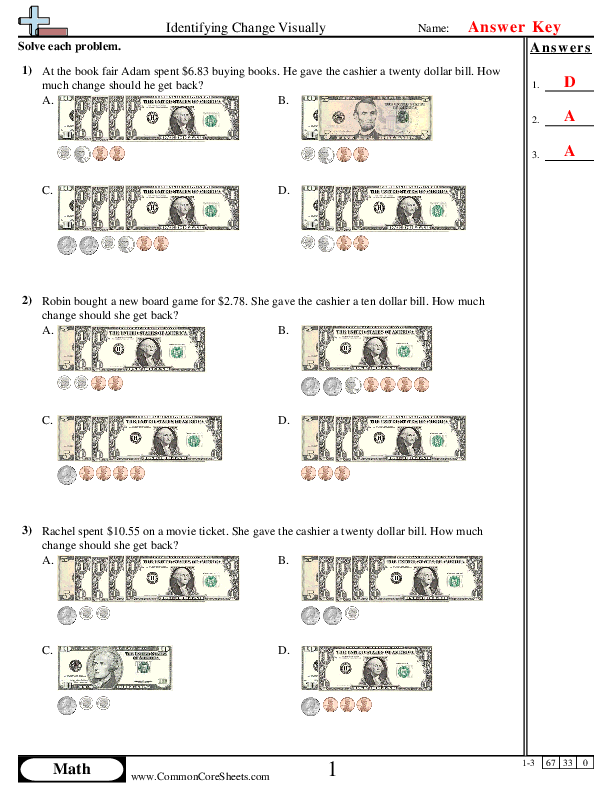
Identifying Change Visually


×
Description:
"This worksheet is designed to teach children the concept of identifying change in math visually, using real-world examples. It contains three problems that depict scenarios at a fair, a book fair, and a mall. These exercises can be customized and converted into flashcards. It's also suitable for distance learning, making it a versatile teaching resource for understanding financial transactions."

×
Student Goals:
Problem-Solving SkillsStudents will gain an understanding of how to effectively approach and solve problems. They will be able to process the given information, identify the question, and use appropriate mathematics operations to find the solution. The specific focus will be on subtracting amounts, which is directly applicable to understanding change in real life transactions.Financial LiteracyLearners will develop basic financial literacy, a vital life skill. By understanding and calculating change for transactions, students will be better prepared for real world situations involving purchases. They will grasp the concept of making payments larger than the cost of a purchase and learn to calculate the change they should receive back.Numerical ProficiencyBy walking through these math problems, students will make progress in their ability to conduct numerical operations, specifically subtraction. They will also further their understanding of decimals, which plays a vital role in managing money and conducting financial transactions. Consequently, learners will be able to handle complex practical math problems with more confidence.Relevance to Real-World ScenariosStudents will learn to apply mathematical concepts to real-world scenarios, in this case, the actual situation of a monetary transaction. This helps to reinforce the relevance and utility of what they are learning, thereby nurturing an appreciation for the practical applications of mathematics.Analytical ThinkingCompleting the worksheet will necessitate the use of analytical thinking skills as learners are not merely applying a formula but also interpreting a narrative problem. This requirement fosters their ability to understand and dissect problems presented in a text-rich format, improving their comprehension capabilities.


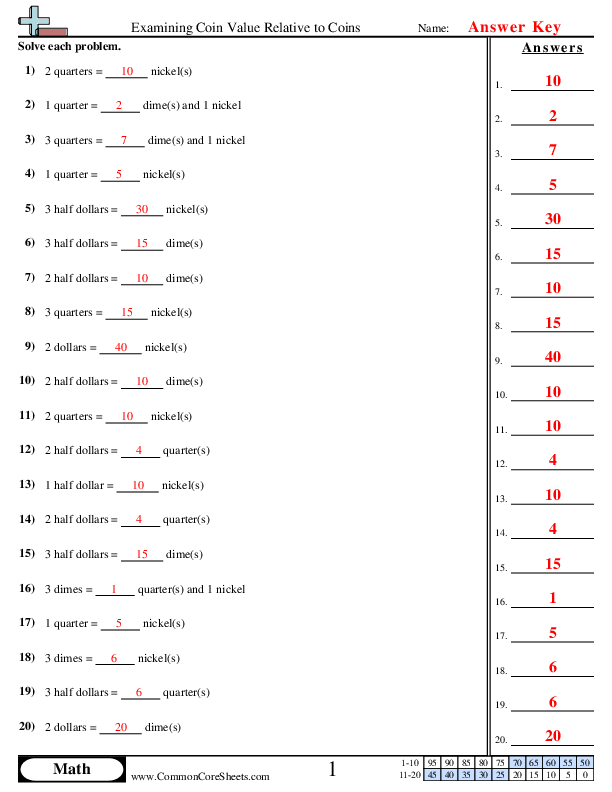
Examining Coin Value Relative to Coins


×
Description:
"This worksheet is designed to instill a strong understanding of coin values in children. The 20 math problems reinforce relations between quarters, dimes, nickels, half dollars, and dollars. It's versatile and can be customized to suit individual learning styles, converted into flashcards for quick review, or utilized as a resource for distance learning. This practical and adaptable tool effectively supports the development of early financial literacy."

×
Student Goals:
Understand Concept of Coin ValuesOn completing this worksheet, students will have gained a strong understanding of the relative value of different coins. They would learn how many of one type of coin is equivalent to another, thereby comprehending the basic principle of coin values in the day-to-day life. Understanding the relative worth of pennies, nickels, dimes, quarters, half-dollars, and dollars will allow them to make correct and confident monetary decisions in real-world situations.Improve Mathematical ProficiencyThe worksheet also helps to improve students' basic arithmetic skills. The ability to quickly and accurately convert between different coin denominations is a fundamental math skill that will also aid in other aspects of mathematical understanding. This activity allows students to practice simple addition, multiplication, and division, which are crucial components in the development of their mathematical proficiency.Enhance Problem-Solving SkillsThese exercises will allow students to enhance their problem-solving skills. They will need to figure out the relationship between different coin values, which involves a level of logical thinking and reasoning. Problem-solving is a universal skill that is used in many areas of life and learning, and this worksheet aids in fostering this skill.Develop Financial LiteracyKnowing the value of coins is the first step towards financial literacy. By practicing such worksheets, students get to inculcate early money management skills. They will learn the importance of each denomination and how they add up to create larger values. This understanding is vital to making wise spending and saving decisions in their future.Boost ConfidenceUpon successful completion of the worksheet, students will feel a sense of achievement boosting their confidence. This will increase their interest in the subject and encourage them to take on more complex problems. Overall, it will help develop a positive attitude towards learning and personal growth.




